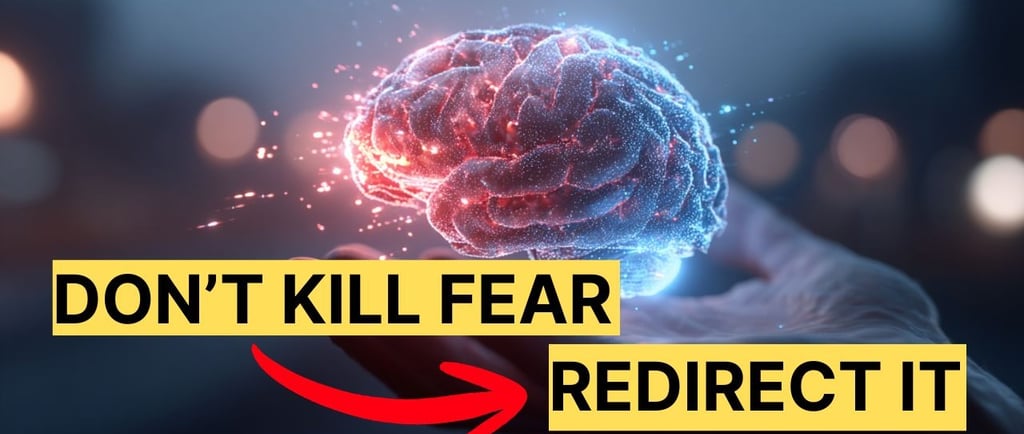Fear Will Never Disappear. Here’s How to Control It
You will always feel some fear or anxiety — it’s how the brain protects you. The reticular formation keeps producing energy, and when you don’t use it, that energy flows into the fear center of the brain, making you worry even without a real reason. The solution isn’t to remove fear but to redirect your energy. When you stay still, the energy feeds anxiety. When you take action — even small tasks like cleaning, cooking, working, or moving toward your goals — the energy shifts from fear to progress. You can’t stop fear, but you can choose where your energy goes. Use it for action, and anxiety becomes weaker.
11/16/20253 min read


Why You Will Always Feel Fear — And Why That’s Not a Problem
One of the biggest misunderstandings people have about fear, anxiety, and worry is this:
They think these feelings should disappear completely.
But the truth is very different.
You will always experience some level of fear, anxiety, or worry throughout your life. This is not a personal weakness. It is not a sign that something is wrong with you. It is simply how the human brain works. Your brain is designed to scan the world for danger and protect you. That system never turns off — and it shouldn’t. Without it, humanity wouldn’t have survived.
Think about your own life.
Maybe you remember a moment when you solved a big problem — a financial issue, a relationship conflict, or a work challenge. You felt relieved and even peaceful. For a few hours or a few days, you told yourself, “Life is good now.”
But soon after, a new problem appeared. Something else became uncomfortable. A new worry came into your mind.
That is completely normal. When one issue disappears, the brain naturally looks for the next thing that might need attention. It’s not trying to torture you. It is trying to keep you alive, safe, and prepared.
The goal is not to eliminate fear. The goal is to learn how to manage fear so it doesn’t control your life.
The Neuroscience Behind Your Fear
To understand this, you need to know a little bit about how your brain works.
Deep inside your brain, you have a structure called the reticular formation. Its job is to generate and regulate psychological energy. Thousands of years ago, this energy helped humans hunt, run, protect themselves, and survive harsh environments.
Back then, people needed enormous amounts of energy every day.
Today, life is different.
You don’t need to hunt.
You don’t need to run from predators.
Food and comfort come to your door with a delivery app.
But your brain still produces the same amount of internal energy as it did thousands of years ago.
So the question is:
Where does this extra energy go?
When your brain generates unused energy, it does not disappear. It has to go somewhere. And for most people, it goes straight into the emotional centers of the brain — the parts responsible for fear, worry, and anxiety.
This is why you sometimes feel anxious “for no reason.”
The energy simply flowed into the wrong direction.
When Energy Hits the Fear Center
When the energy from the reticular formation hits the parts of your brain responsible for fear, the result is predictable:
You start worrying about small things.
You imagine negative outcomes.
You feel tension in your chest or stomach.
You become restless, distracted, or overwhelmed.
You overthink everything.
Nothing objectively dangerous happened — but internally, it feels like something is wrong.
This is not emotional weakness.
This is your brain trying to use the energy it produced.
How to Redirect This Energy
Here is the most important part:
You cannot stop the brain from producing energy,
but you can choose where that energy goes.
When you don’t choose, it automatically flows into fear.
When you take control, it flows into action.
To redirect your energy, you need simple, concrete tasks that produce real results. This could be:
finishing the dishes
completing a small project
exercising
organizing your space
cooking
learning something
doing your hobby
working on your project
calling a friend
working on your business
Your goal is to spend as much energy as possible on tasks that make your life better, happier, or more interesting, and it creates a visible, positive result.
The moment you start doing something useful, the energy stops feeding your fear and starts feeding your action. You shift from being a “person who is scared” to a “person who takes action.” And the brain responds immediately — fear reduces and a sense of control increases.
Fear Will Always Be There — But It Doesn’t Have to Control You
You will always have moments of fear, worry, and anxiety. That is simply part of being human. But when you learn to direct your internal energy toward productive actions — actions that create progress, results, and happiness — the fears lose their power.
Fear will still appear, but it will no longer control your life.
You will develop the skill of transforming fear into movement, progress, and growth.
And when you master this, your life becomes clearer, calmer, and more meaningful — not because fear has disappeared, but because you have learned how to lead your energy, instead of letting your fear lead you.
